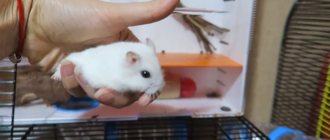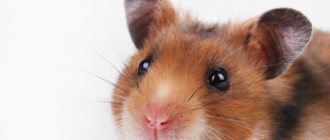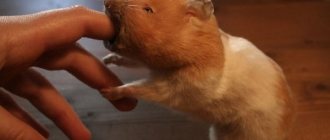The death of a pet is always associated with disappointment and heartache. Those who are planning to get a hamster should remember that its life is very short. Even in ideal conditions, the rodent will die within 2-3 years. If you do not surround the animal with care and love, then its life will end even faster.
Let's find out what most often causes pet hamsters to die, how to determine the approach of death, and what to do in the event of the death of a pet.
Causes of death of a hamster
A pet can die for a number of reasons.
Poor nutrition
If the owner offers the pet prohibited treats, it may die. The diet should not include sweets, baked goods, lard, sausages, fried meat, or salty dishes.
Spicy, acidic foods corrode the walls of the gastrointestinal tract and provoke the formation of ulcers. Death because of them can be long and painful.
Fatty foods cause severe diarrhea and death from dehydration. For small animals, a small piece is enough to get poisoned.
Intoxication is also possible when a rodent eats improperly stored food. If a pet eats moldy grain, it will experience diarrhea and vomiting, convulsions, possible difficulty breathing, then paralysis and suffocation.
The hamster must have proper nutrition.
Bad content
To keep your hamster healthy, you need to regularly clean its cage. If you neglect cleaning, do not remove excrement, rotten food, or change the water in the drinking bowl, the animal will contract a bacterial infection, which can cause its death.
When selecting a cage, consider the number of animals that will live in one area. Too small an area shortens the life of pets. You cannot house two males together, or a male with a pregnant or recently given birth female.
Stuffiness or drafts
For Syrian hamsters and dzhungariks, a temperature regime of +20...+24° C is considered suitable. A draft or severe overheating can lead to the death of the animal.
Hypothermia provokes colds.
Placing the cage in direct sunlight is dangerous not only due to the risk of overheating. Excess light disrupts the hamster's daily routine.
Death during childbirth and difficult pregnancy
Females often die if they become pregnant and give birth before reaching the age of 4 months. Lethal outcome is possible with a large number of cubs. Too frequent childbirth depletes the female's strength. Individuals that regularly bear offspring die earlier.
Heart and other diseases
Cardiac, inflammatory, bacterial, viral, and oncological pathologies often lead to death. With timely treatment, the hamster can sometimes be saved.
Severe diseases, however, cannot be cured in most cases. Death is possible due to parasite infestation. At the first signs of illness or suspicion of helminthiasis, contact a veterinary clinic.
Improper treatment of such diseases can also lead to death or complications. Never try to make a diagnosis or select medications on your own.
Death by fright
Djungarian hamsters are shy, sensitive animals.
The following can lead to cardiac arrest:
- sharp loud sounds;
- contacts with large predators, including dogs or cats;
- change of place of residence;
- long journey.
Under no circumstances should you scare hamsters.
Injuries
Death from injuries is possible if the pet is handled carelessly. If the owners let the hamster wander around the table, the animal may fall from a height. If the neck, back are injured, or internal organs are ruptured, the rodent does not survive. Death can be instantaneous. Less commonly, the animal dies within a few hours of the incident.
Aging
The normal lifespan of a hamster is 2-3 years. An animal older than 1.5 years is considered elderly. Gradually, his activity decreases, the hamster becomes calmer, and is less interested in toys.
The rodent stops running in the wheel and does not show curiosity. The older the animal gets, the less often it plays with its owner. The paws weaken, causing the pet to become clumsy and slow. His appetite decreases. In this case, there are no signs of any pathology.
Stress
Sometimes death due to nervous overstrain occurs instantly, but more often the pet dies within 24 hours. After moving to a new family, do not let your children play with the rodent all evening. He may get scared, which will lead to death in the morning.
A change in regimen can have a negative impact on your pet's health. Frequent disruptions to the usual daily routine make the rodent nervous and lead to premature death.
You cannot wake up a sleeping animal, pick it up, or forcibly pull it out of the cage, since such actions also cause nervous strain.
Due to anesthesia
Substances that negatively affect the health of animals are used for anesthesia. If the pet was sick or weakened, the consequences will be more severe. The procedure is permissible only in rare cases when the animal will definitely die without the operation.
Out of melancholy
If you don't play with your hamster, he will become bored, which will greatly shorten his lifespan. Due to melancholy, the pet becomes apathetic and begins to refuse food or water.
Be sure to take time to play and interact with your pet.
What to do after
After the death of a hamster, it is important to thoroughly disinfect all the accessories that were in its cage, and the cage itself too. If you are going to get another hamster, it is important to completely kill the smell of the previous owner
It is necessary to determine the cause of the pet’s death in order to avoid fatal mistakes in the future.
If you take responsibility and get a hamster, you must provide him with comfortable living conditions. Don’t forget: your pet is just a page in your life, but you are his whole life. Take care and love your pet so that you don’t regret anything when the time comes to part ways.
https://localvet.ru/veterinariya/gryzuny/gibel-homyaka https://pets2.me/bok/1408-chto-delat-esli-homyak-umiraet.html https://fb.ru/article/381022/ chto-delat-esli-umer-homyak-kak-pohoronit-homyaka
Signs of death in a hamster
It is possible to determine the approaching death of a pet by behavior and external changes.
Behavioral features
The animal becomes lethargic and apathetic. Does not want to communicate with its owners or other rodents. The animal does not show curiosity, does not strive to get out of the cage, and does not show interest in food. The rodent stops storing food because it feels that it will soon die and will no longer need food.
If a decrease in activity is observed during the cold season, make sure that the hamster is not hibernating. External signs are similar to the symptoms of a number of diseases and manifestations of old age.
External symptoms
It is possible to recognize approaching death by a number of external signs:
- Sudden weight loss. An animal that senses the approach of death ceases to be interested in food, which is why it quickly loses weight and loses adipose tissue.
- Dullness of the eyes. The organs of vision cease to shine and gradually become more and more cloudy.
- Condition of the coat. Hair becomes dull and thins. Several hairs may stick together to form “icicles.”
Animals behave differently. Some hamsters die quietly. Others begin to “cry”, gradually these sounds turn into wheezing.
Dull eyes and refusal to eat are some of the signs.
Statement of death
Unlike animals in a torpor, the dead do not breathe and have no pulse. To check, hold a mirror to the animal’s nose. If it fogs up a little, the hamster is still alive. The dead animal cools down within several hours. During torpor, body temperature decreases slightly.
Deadly diseases
What is the most common cause of death for babies? The cause of premature death of a hamster can be a variety of diseases:
- tumors;
- infectious and cold processes;
- metabolic disorders;
- diseases of internal organs.
How do you know if your hamster may be dying? In a sick rodent:
- loss of appetite;
- noticeably depressed state;
- stool is disturbed;
- breathing and heart rate changes;
- skin condition worsens;
- the cornea of the eyes becomes cloudy;
- motor activity changes;
- depression or overexcitation is observed.
Due to their small size, it is very difficult to diagnose the problem in time; many diseases have a lightning-fast course. Usually the owner begins to sound the alarm when it is too late to treat the pet.
Separately, it is worth mentioning the death of the female and (or) offspring during childbirth.
Has your hamster died or hibernated?
Is it possible to save a dying hamster?
In some cases, it is possible to resuscitate a dying animal.
In what cases is it possible
Young animals are more often saved. If you notice signs of a cold, loss of appetite, change in coat quality, or lethargy, contact your veterinarian immediately. The doctor will tell you how to help your hamster, select the appropriate treatment if necessary, and give advice on caring for the rodent.
When you can't help
If the hamster is already old, paralyzed or seriously injured, it will not be possible to “resurrect” it. It is also impossible to cure oncological pathologies and severe infectious diseases. In such situations, it is recommended to euthanize the animal, since hamsters with such diseases die for a long time, painfully.
Kidney diseases
Degenerative kidney disease affects older hamsters and has a higher prevalence in females, with the formation of amyloid deposits being an associated event.
Some evidence suggests that hamsters eating a diet higher in protein may increase the chances of nephritis. One study found that hamsters fed diets containing 12% protein had both comparable body size to hamsters fed diets containing 18% and 24% protein, but a lower incidence of nephritis.
How to prevent an animal's early death
To extend the life of a rodent, follow a number of recommendations:
- Give your pet only food that is suitable for him. Food from the owners' table can harm the animal's health and cause severe discomfort, illness, and death. The food must be fresh.
- Keep the cage clean.
- Eliminate potential sources of stress whenever possible. Noisy electrical appliances, cats, and dogs should not enter the room where the hamster lives.
- At home, you should not wash rodents unless necessary. The cage must be placed in a warm, but not too hot place.
- Play with your hamster regularly and take care of it. The animal must feel the love of its owners.
- Take your pet to the veterinarian periodically. The doctor will be able to detect the symptoms of dangerous diseases in time and tell you what to do to prolong the life of the animal.
- Don't breed females too early.
Visit your veterinarian regularly with your pet.
Basic rules for life extension
We humans, the owners of our pets, cannot understand what feelings our charges experience before death, but we have the power to provide proper care and thereby delay the unpleasant and saddest outcome for everyone - the death of the hamster. Make sure that you have created not only the necessary comfortable conditions for your pet, but also surrounded him with care and love, namely:
- Provide your ward with healthy and at the same time proper nutrition, which is very necessary to maintain and strengthen his immunity. A rodent's diet must include not only grains and nuts, but also fresh vegetables and fruits. In addition, the rodent should always have fresh water, both for drinking and for washing.
- Create an opportunity for the animal to lead an active lifestyle - place in its cage not only a running wheel, but also other toys necessary to maintain excellent physical shape and strengthen the rodent's cardiovascular system.
- The cage should be placed in a well-ventilated area, but away from drafts and direct sunlight.
- Do not forget that hamsters do not react well to the noise of electrical appliances. Animals around them become restless, their sleep is disturbed, and there are times when they fall into a state of depression.
The owner's love, warm care and joint games between pet and owner work wonders, and proper care of a hamster will help extend its life for months, or even years.
« Previous entry
How to properly bury a hamster
Place the deceased pet in a cardboard box. Then choose a suitable burial place. It is better to do this in the forest or in a field, away from residential buildings. Dig a hole 30-40 cm deep, then place the container inside and cover it with earth.
If you cannot bury the animal yourself, contact a veterinary clinic. There, for a small fee, the animal is cremated. More often, the animal is burned along with other dead pets, but a number of clinics offer individual cremation, in which only one body is sent to the oven.
Diabetes
Diabetes is rare or uncommon in hamsters other than the Chinese hamster, especially those from inbred lines. “Dwarf” breeds of hamsters are generally more prone to diabetes. It involves elevated blood sugar levels caused by insufficient production (or ineffective use) of insulin.
Symptoms of diabetes in hamsters include increased thirst, drinking and urinating, as well as weight loss, lethargy and a strong urine odor. It may be possible to treat diabetes in hamsters using a special diet to prolong their life.
These are just a few of the diseases and conditions that can seemingly kill hamsters quickly, with little notice. It is important to remember that there are other possible ways hamsters may die unexpectedly, and to carefully investigate each circumstance with an open mind. It is usually never possible to find any evidence to make a definitive conclusion about what happened, so don't be discouraged by the lack of answers, and if you decide to get another hamster, make sure you care for your pet to the best of your ability, giving special attention to diet, enrichment and enclosure design, reducing stress as much as possible.
Tips for coping with the loss of a pet
The lifespan of rodents is short. Children who have lost a pet are very worried, and parents do not know how to help them, how to survive the death of a hamster.
To make it easier to come to terms with your loss, follow these recommendations:
- Do not hide from your child that your pet has passed away. He has to learn that animals die one day and it is impossible to revive them. Lying can lead to loss of trust in parents.
- Don't hold back your feelings and don't stop your children. They need to mourn their lost pet.
- Reminisce with your child about happy moments associated with animals.
You shouldn't get a new pet right away. It’s better to let the heartache pass and only then go for a new furry friend.
Wet Tail
"Wet tail" is a general term used to describe diarrhea in hamsters and may also be called proliferative ileitis, regional enteritis, terminal ileitis, regional enteritis, enzootic intestinal adenocarcinoma, atypical ileal hyperplasia and hamster enteritis in golden hamsters. It is one of the most common spontaneous diseases of hamsters and is often isolated as a bacterial infection in young hamsters (3-10 weeks).
Diarrhea in adult hamsters may be due to bacteria; they cause Tyzzer's disease and are associated with parasites, overcrowding, high fever, malnutrition and stress. Cryptosporidium infection has also been associated with wet tail. It is observed only in animals with weakened immune systems.
An easy way to tell if your pet has had a wet tail is by looking for moisture around the hamster's genital area. They may also become dehydrated. Other symptoms include weight loss, anorexia, dirty coat, lethargy and hunched posture. Stress may be a contributing factor in the development of this disease. Sometimes survivors of wet tail may develop and die from a complete or partial ileal obstruction. Unfortunately, it has a mortality rate of up to 90%, and death usually occurs within 24-48 hours after the first symptoms appear.
Hamster diseases and their treatment. If your hamster is breathing heavily through his mouth
Due to excitement, it is difficult to figure out what to do if the hamster lies and does not move, but is breathing. After all, the presence of breathing means that the animal is still alive.
Before you run to the vet, you need to try to figure out why your pet is lying motionless
Pay attention to other signs: whether the eyes are closed, how often the rodent breathes. If the eyelids are closed and breathing is calm, the hamster may just
If a previously healthy animal suddenly falls into a coma, it is possible that it is hibernating. Breathing will be very rare, and the pet will be cold to the touch. In nature, dwarfs hibernate in winter, waiting out cold, hunger and short daylight hours.
Increased ambient temperature
Small rodents, despite the fact that in the wild they can live in steppes, deserts and semi-deserts, do not tolerate heat well.
Prolonged exposure to high temperatures can lead to heat stroke.
Signs of this condition will be:
- Trembling when touched
- Convulsions
- Weakness and indifference
- Coordination of movements is impaired
- The hamster lies on its side and breathes heavily
Sudden overheating can lead to heart failure, which can be fatal. Such rodents do not have the body's natural protective functions in the form of sweat or mouth breathing.
If the animal is lethargic, but the exposure to high temperatures has not been for a long time, then the first aid will be to move it to a cooler room and spray cold water over it from a spray bottle.
A quick way to cool the body is to place the animal under a stream of cold water, holding the muzzle so that the hamster does not choke.
Temperature-related disorders
If the hamster did not show the slightest signs of illness and suddenly fell into an unconscious state, it may be hibernating. In the natural environment, Djunga hamsters retire in winter, experiencing cold weather, periods of lack of food and insufficient lighting. The other extreme is overheating of the hamster, and this is much more dangerous than cooling, since the small animal is absolutely defenseless against high thermometer readings. It is overheating that most often becomes the cause of death for a rodent.
Low room temperature
Turning off the heating or leaving a window open for a long time on a frosty day can cause the hamster to fall into torpor. In this case, the body will be very cold, and the heartbeat will slow down significantly - to one beat every fifteen seconds. A sleeping hamster barely breathes and due to its small size it is quite difficult to determine how intense the breathing is and whether it exists at all. But if the body is soft to the touch, this means that the rodent is alive.











